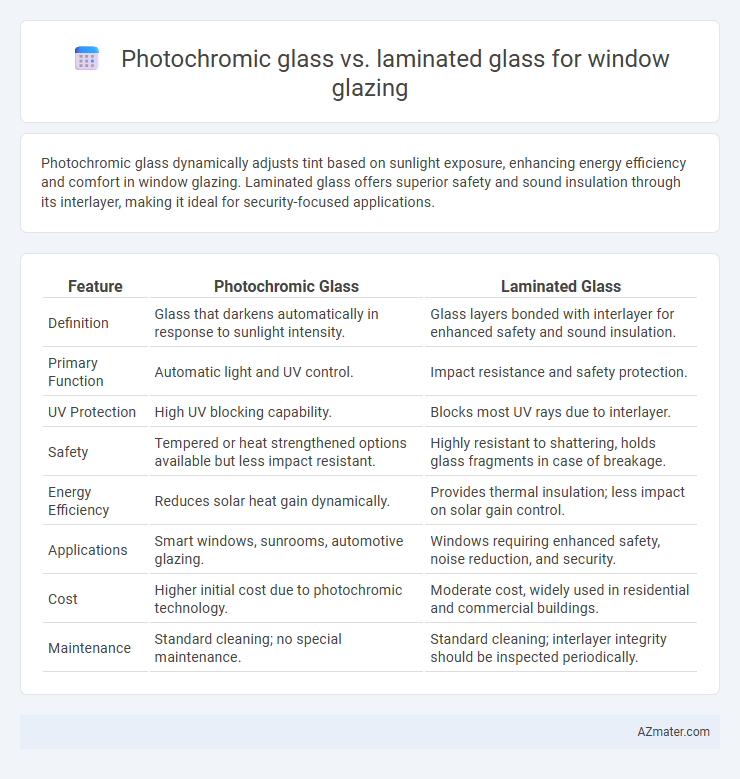Photochromic glass dynamically adjusts tint based on sunlight exposure, enhancing energy efficiency and comfort in window glazing. Laminated glass offers superior safety and sound insulation through its interlayer, making it ideal for security-focused applications.
Table of Comparison
| Feature | Photochromic Glass | Laminated Glass |
|---|---|---|
| Definition | Glass that darkens automatically in response to sunlight intensity. | Glass layers bonded with interlayer for enhanced safety and sound insulation. |
| Primary Function | Automatic light and UV control. | Impact resistance and safety protection. |
| UV Protection | High UV blocking capability. | Blocks most UV rays due to interlayer. |
| Safety | Tempered or heat strengthened options available but less impact resistant. | Highly resistant to shattering, holds glass fragments in case of breakage. |
| Energy Efficiency | Reduces solar heat gain dynamically. | Provides thermal insulation; less impact on solar gain control. |
| Applications | Smart windows, sunrooms, automotive glazing. | Windows requiring enhanced safety, noise reduction, and security. |
| Cost | Higher initial cost due to photochromic technology. | Moderate cost, widely used in residential and commercial buildings. |
| Maintenance | Standard cleaning; no special maintenance. | Standard cleaning; interlayer integrity should be inspected periodically. |
Introduction to Window Glazing Options
Photochromic glass dynamically adjusts its tint in response to sunlight, reducing glare and controlling heat transmission, enhancing energy efficiency in window glazing. Laminated glass consists of two or more layers bonded with an interlayer, offering superior safety, sound insulation, and UV protection. Both options improve comfort and security, with photochromic glass prioritizing light control and laminated glass emphasizing structural strength.
What is Photochromic Glass?
Photochromic glass is a smart glazing material that automatically adjusts its tint in response to sunlight intensity, reducing glare and controlling heat gain for enhanced energy efficiency. Unlike laminated glass, which consists of multiple layers bonded with a plastic interlayer for safety and sound insulation, photochromic glass actively modulates light transmission through embedded photo-sensitive molecules. This dynamic property makes photochromic glass ideal for smart windows, improving occupant comfort and reducing reliance on artificial lighting and air conditioning.
Understanding Laminated Glass
Laminated glass consists of two or more glass layers bonded by an interlayer, typically made of polyvinyl butyral (PVB), providing enhanced safety and sound insulation. Its design prevents shattering upon impact, making it ideal for security-conscious window glazing applications. Unlike photochromic glass, which dynamically adjusts tint based on light exposure, laminated glass offers consistent protection and durability without changing transparency.
Key Differences Between Photochromic and Laminated Glass
Photochromic glass dynamically changes its tint in response to UV light, providing automated glare reduction and energy efficiency, while laminated glass consists of multiple layers bonded with an interlayer for enhanced safety and sound insulation. Photochromic glass is ideal for adaptive indoor comfort and sun control, whereas laminated glass excels in impact resistance and security applications. The choice between these types depends on whether smart light modulation or structural protection is the primary glazing requirement.
UV Protection: Photochromic vs Laminated Glass
Photochromic glass dynamically adjusts its tint based on UV exposure, providing variable UV protection that increases with sunlight intensity, whereas laminated glass offers consistent UV blocking through its polyvinyl butyral (PVB) interlayer that filters out nearly 99% of harmful UV rays. Photochromic glass is ideal for environments with fluctuating light conditions, reducing glare and UV exposure when needed, while laminated glass ensures continuous UV protection and added safety by holding glass fragments together upon impact. Both types are effective for UV protection in window glazing, but laminated glass delivers static and reliable UV filtering, and photochromic glass offers adaptive shading alongside UV defense.
Safety and Security Aspects
Photochromic glass enhances safety by dynamically adjusting tint to reduce glare and UV exposure, improving occupant comfort without compromising visibility. Laminated glass offers superior security through its multi-layer construction that resists impact, prevents shattering, and acts as a barrier against break-ins. Combining laminated glass with photochromic technology can optimize both safety from physical harm and protection against harmful solar radiation.
Energy Efficiency Comparison
Photochromic glass dynamically adjusts its tint based on sunlight intensity, reducing solar heat gain and lowering cooling energy consumption in buildings. Laminated glass, while providing enhanced security and sound insulation, generally offers less impact on energy efficiency since it lacks adaptive solar control properties. For optimal energy savings in window glazing, photochromic glass outperforms laminated glass by actively minimizing HVAC loads through real-time modulation of light and heat transmission.
Cost Considerations and Long-term Value
Photochromic glass typically involves higher initial costs due to advanced technology that adjusts tint based on sunlight, reducing energy expenses over time through decreased cooling needs. Laminated glass features moderate upfront costs with enhanced safety and noise reduction benefits, yet may require replacement sooner if damaged, impacting long-term value. While photochromic glass offers energy savings and comfort, laminated glass provides durability and security, making cost-effectiveness dependent on specific application priorities and maintenance factors.
Ideal Applications for Each Glass Type
Photochromic glass is ideal for window glazing in environments requiring dynamic light control and energy efficiency, such as office buildings and residential spaces with abundant sunlight, as it automatically darkens under UV exposure to reduce glare and heat. Laminated glass suits applications demanding enhanced safety and security, including schools, hospitals, and commercial buildings, due to its shatter-resistant interlayer that holds glass fragments together upon impact. Combining these glass types can provide both adaptive solar control and structural safety in complex architectural projects.
Choosing the Right Glass for Your Windows
Photochromic glass automatically adjusts tint based on sunlight intensity, reducing glare and UV exposure, ideal for energy-efficient window glazing in variable light conditions. Laminated glass consists of layers bonded with a plastic interlayer, providing enhanced security, sound insulation, and UV protection, making it suitable for safety-focused glazing applications. Selecting the right glass depends on balancing light control, energy efficiency, and impact resistance tailored to your specific window needs.

Infographic: Photochromic glass vs Laminated glass for Window glazing
 azmater.com
azmater.com